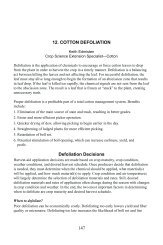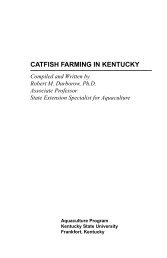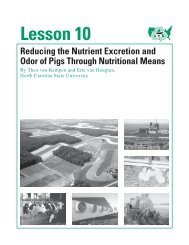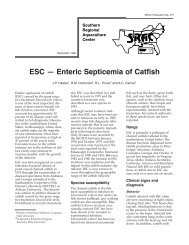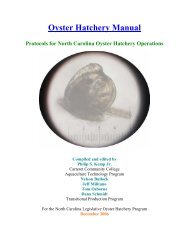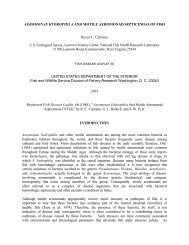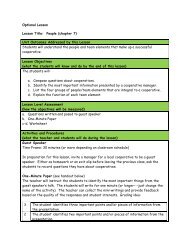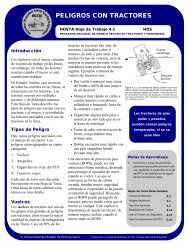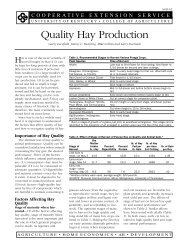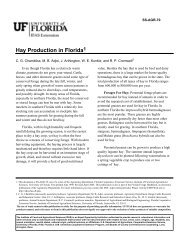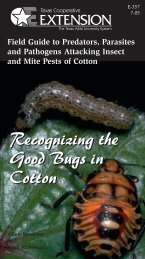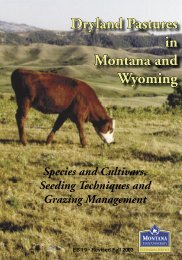Hybrid Striped Bass: - SRAC Fact Sheets
Hybrid Striped Bass: - SRAC Fact Sheets
Hybrid Striped Bass: - SRAC Fact Sheets
You also want an ePaper? Increase the reach of your titles
YUMPU automatically turns print PDFs into web optimized ePapers that Google loves.
to cannibalism. To help prevent it,<br />
provide artificial feed to supplement<br />
the zooplankton.<br />
Supplementation also helps to<br />
wean the fingerlings so that they<br />
are ready for tank culture or culture<br />
in ponds with prepared<br />
feeds. Fry can survive on finely<br />
ground high-protein feeds after<br />
they are 26 days old or after<br />
about 3 weeks in the pond.<br />
Before they reach that stage, food<br />
such as a 45% or greater protein<br />
starter meal should be cast on the<br />
ponds one to three times a day at<br />
the rate of 2 to 10 pounds (0.9 to<br />
4.5 kg) per acre per day. Mashes<br />
are fine enough that they may<br />
also be consumed by some zooplankton<br />
species. Fingerlings eating<br />
this zooplankton may become<br />
accustomed to prepared feeds<br />
more rapidly than when larger<br />
food is offered first. The size of<br />
the feed should be increased to a<br />
number one crumble when the<br />
fry are about 4 weeks old. At 4 to<br />
5 weeks of age the fish should<br />
start feeding at the surface. After<br />
a few days of surface feeding the<br />
fingerlings’ feeding behavior<br />
makes it possible to adjust the<br />
feeding rate. Feed should be<br />
applied to the pond until obvious<br />
feeding stops. A few minutes later<br />
check for uneaten feed and adjust<br />
the amount given accordingly.<br />
Harvesting fingerlings<br />
Harvesting is another critical time<br />
in the culture of sunshine and<br />
palmetto bass. These fish, particularly<br />
the palmetto bass, are highly<br />
susceptible to shock brought<br />
on by physical or chemical stress.<br />
Highly stressed fingerlings often<br />
have tetanized muscles that cause<br />
the fish to curl. Stress during harvesting<br />
may kill fingerlings or<br />
make them highly susceptible to<br />
future disease. Prevent stress by<br />
handling fish carefully, maintaining<br />
high levels of dissolved oxygen,<br />
preventing chemical or temperature<br />
shocks, and using salt.<br />
After 30 to 45 days the fingerlings<br />
should be harvested and graded.<br />
If this is not done cannibalism<br />
may cause significant losses.<br />
Harvesting is done with a 1 /4-inch<br />
mesh seine or by draining ponds<br />
that have catch basins. When<br />
seines are pulled to the bank it is<br />
important to cast salt on the area<br />
where fish are concentrated and<br />
to ensure that high levels of dissolved<br />
oxygen are maintained. A<br />
water pump or compressed air<br />
aeration can provide dissolved<br />
oxygen and keep the water clean.<br />
Do not let fish become crowded in<br />
the seine.<br />
Survival can be estimated during<br />
harvesting. One method is to add<br />
fingerlings to buckets that are<br />
one-third to one-half full of water<br />
and have been weighed on a<br />
scale. Weigh the buckets again<br />
with the fish and add up the total<br />
weight of fish harvested. Then<br />
count out a small number of fish<br />
and weigh them to get the average<br />
weight per fish. Divide that<br />
weight into the total weight harvested<br />
to get the total number of<br />
fish harvested. That number<br />
divided by the number of fry<br />
stocked gives the survival rate.<br />
Experienced sunshine bass farmers<br />
average 25 to 40 percent survival.<br />
Fingerlings should be removed<br />
from the seine without delay,<br />
using 1 /4-inch, uncoated nets, then<br />
placed in buckets of water and<br />
loaded into a hauling truck that<br />
contains salted water (up to 10<br />
grams per liter). Use salt that does<br />
not contain anti-caking compounds<br />
that may be toxic to the<br />
fish. Dissolved oxygen levels<br />
should be maintained at 5 mg/L<br />
or higher. If possible, use water<br />
from the pond being harvested.<br />
Upon reaching the holding shed,<br />
make sure the fish are not<br />
shocked by rapid changes in<br />
water temperature. Temper the<br />
fish by having water similar to<br />
that in the holding vats pass into<br />
the tanks on the hauling truck.<br />
Allow about a half hour for each<br />
4 °F (2 °C) difference in water<br />
temperature.<br />
Transfer the fingerlings to a tank<br />
where they can be graded the<br />
next day. The largest and the<br />
smallest fish should be separated<br />
from the rest. The largest fish are<br />
probably cannibalizing smaller<br />
fish, and the smallest fish are<br />
probably not acclimating well to<br />
prepared feed. The middle-sized<br />
group may be further divided<br />
into groups for shipment to customers,<br />
placement in grow-out<br />
ponds or tanks, or later shipment<br />
to grow-out facilities. More than<br />
one grading, particularly for fish<br />
held in tanks, is often necessary.<br />
Before being restocked the fingerlings<br />
should be further trained to<br />
eat a prepared diet of at least 45<br />
to 50 percent protein. Determine<br />
the proper size to feed by experimentation,<br />
starting with striped<br />
bass feed or salmon starter in<br />
number 1, 2, 3 or 4 crumble.<br />
Fingerlings that are sold should<br />
be acclimated to cool water and<br />
allowed to purge for at least a day<br />
before being shipped. The shipping<br />
water should be salted (0.5<br />
to 1% or 5 to 10 g/L NaCl 2 , CaCl 2 ,<br />
or sea salt) to reduce the effects of<br />
stress. A commercial anti-ammonia<br />
compound is also added to<br />
the water. If the fish are going to<br />
be shipped by air (and sometimes<br />
by ground) they are placed in a<br />
few gallons of salted water and<br />
into doubled plastic bags that are<br />
inflated with oxygen and then<br />
placed into an insulated shipping<br />
box and sealed. Large shipments<br />
by ground transportation are<br />
loaded into insulated compartments<br />
on a hauling truck that has<br />
a supply of liquid oxygen and an<br />
aeration system. Dissolved oxygen<br />
should be kept above 5<br />
mg/L. The water should be agitated<br />
to prevent buildup of carbon<br />
dioxide. Temperatures should<br />
be kept below 70 °F (21 °C).<br />
It is important to fully coordinate<br />
the timing of harvesting and hauling<br />
operations with customers.




